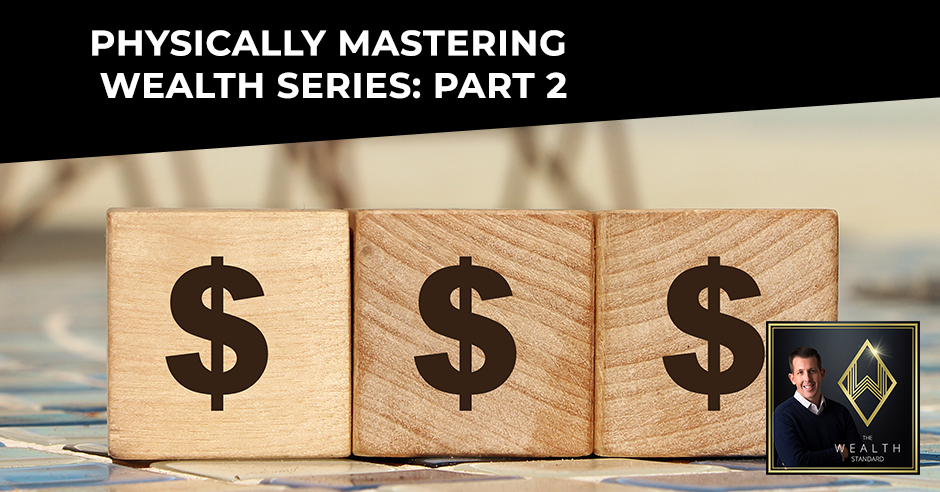Physically Mastering Wealth Series: Part 2
Podcast: Play in new window | Download

Welcome back to the third part of the three-part series on physically mastering wealth. Today, Patrick Donohoe is going to talk to you about two very different stories. One is about a family that saved too much money, the other is about a family that spent it all. Join in and learn from these stories so that you can apply the three financial habits for a happier life. Force these habits into your life today!
—
Watch the episode here:
Listen to the podcast here:
Physically Mastering Wealth Series: Part 2
One of the driving forces of human beings is freedom, which infers financial freedom, too. Several years ago, I set out to discover how any individual, regardless of their financial situation, could evaluate their finances in five minutes or less, and have a firm date when they could achieve financial independence. The latest version of this calculator, which is free for readers, can be found at TheWealthStandard.com/calculator. The calculator is going to take you a few minutes to complete and it’s going to provide you with a specific financial independence date. Go check it out.
Introduction
This is the third part of a three-part series on Wealthy Habits. The end result of why I’m doing this series is so that an individual like yourself can show up to life even better, have a more abundant experience of each moment. I look at finance as being one of those topics that weigh on the mind of people constantly and influence the way they show up to life, which is, as you can imagine, not positive.
The First Story
I’m going to tell two stories. One of, someone who saved almost all of his family’s money and someone who was living paycheck to paycheck and how the 3 habits of 3 things I’m going to talk about that are applicable to both being able to get that same end result, which is a more enjoyable experience of life because of the specific mindset that it produces. Let’s start with the first story.
First off, if you have not read to the first two episodes of this three-part series, please go back and do that because you will understand the idea of physical mastery, which is the establishing of specific habits and how those habits will influence the lion share of your behavior. These habits are strategically designed, not the result of happenstance, which is usually the case with people but to get specific outcomes that people generally desire.
When your expenses exceed your monthly cash flow, start treating your savings as a family bank. Click To TweetLet’s talk about this first family. This client of mine came to me and was making a ton of money through a series of unfortunate events and very painful lessons. He became the CEO of this specific company. At the time, he was making a lot of money, almost seven figures but he was saving the majority of it and came to find out the upbringing that he had drastically influenced what he did with the money. There was a very scarce mindset. They saved everything, scrimped, and did not go on many vacations or travel, even though the family had the means to do that in spades. He was carrying that same behavior into his family.
The Second Story
Saving the majority of money investing, he was very meticulous in the way that he balanced his portfolio and asset allocation very astute and well off. At the time of meaning, he didn’t necessarily have to work another day in his life but he kept working 50-60 hour weeks, saving the majority of his money but it came down to not necessarily experiencing out of life what he wanted. There are solutions to this. I’m going to go to the next story, which did not end very well.
The next story is about a couple who had a pretty nasty divorce but their entire marriage revolved around arguing about money. They were living beyond paycheck to paycheck, didn’t understand lifestyle expenses, and equated what they spent on what they thought they were making, which wasn’t what they were making. What this led to is a lot of fighting and to the point where there was a divorce and kids involved. It was bad.
At the same time, looking at where their behaviors came from, it was associated with the environments that they grew up in. One was an environment where they never had any money and that which they had to spend on food, clothes and transportation. Oftentimes, they didn’t have any money to spend. The other came from a lower-middle-class family and was making more than his parents but it was always this never saving, investing or having any plan associated with money.

Physically Mastering Wealth: When it comes to the actual implementation of these strategies, there are two ways to approach establishing habits. You can force it or you can consistently do it.
The Three Financial Habits
Here are the financial habits that ultimately impacted. The first family was a little too late with the second family that I was working with. Moving beyond that, they had made some changes once the divorce was final but I’m going to focus on this first family but in the end, these principles equally apply. I want to make sure that you understand that we all have financial habits. We didn’t necessarily strategically design them for this specific end result that we wanted. You can unpack these three financial habits in multiple layers. I’m going to speak to them generally and I’m going to give you some resources that you can learn more about them if you want.
It’s the establishing of three habits. The 1st habit is a spending strategy, 2nd habit is a savings strategy and the 3rd habit is an investment strategy. It’s not very complicated but when it comes to the actual implementation of these strategies, there are two ways to approach establishing habits. You can force it or consistently do it as I talked about in the last episode. Sixty days is the average. Forcing it, though, sometimes allows you to not have an out. Even though you do have an out, you can put yourself in an environment where the out is very difficult.
Let’s first talk about spending. There’s a principle of pay yourself first that’s talked about in a lot of different books but I agree with that and essentially have money carved out of the top of what you take home as your income as savings. It’s a 10/10/10 Rule. Ten percent off the top goes to savings, 10% goes to investment, 10% goes to charity, and ultimately, you live on 70% of your net take home.
These can vary. I’m only talking about general rules. Some might not be possible right away for some people and it may require some weaning in over some time but for this first-person, that first story I told you about, it took a lot to go from trying to save 70% to 75% of your take-home to only savings and investment about 20%. You are going to have to change some of your behaviors regardless but behind forcing it, what that does is allows you to look very closely at your spending, which is going to be 70% of your take-home.
Why are you earning, spending, and investing in the first place? It's to have a better experience of life. Click To TweetThis may require a lifestyle change. Maybe it’s living in a small house, a smaller car, going on fewer vacations but 70% we put that into what I recommend most often, which is a spending account. There’s a set amount of money that each month, that’s all that you can spend. When it’s gone, then you can’t spend any more. Go figure but you forced this upon yourself.
You set it up, which means that you can easily retract it at the same time, forcing it to happen allows your behavior to be modified very quickly. In the beginning, it’s going to be painful. It’s like someone who hasn’t worked out a long time but commits themselves and almost forces themselves into a new workout routine. You are going to feel some pain and soreness until your body gets used to it. In this case, until your financial life gets used to it.
There are instances where there are big expenses, whether it’s a college, car or vacation. What I typically recommend, what I do in my own family, is when expenses exceed a certain level that’s not within our monthly cashflow, then you essentially treat your savings as a family bank, lend it to the specific spending account so that you can go on vacation, buy a new car and XYZ your house, then you repay on a schedule that a bank would force you to repay back at. For more information on that, you can check out the new courses that we have up and running, the Wealth Map. It’s only $497. Go to the website and you can pick that up. There’s a commercial too that you have probably noticed that teaches that concept.
I’m going to go at what level do you stop those savings. I believe there is an excess of savings. First off, 6 to 12 months of liquid savings are adequate to produce that abundance mindset. Maybe one month of cash. These months equate to all of your living expenses for that specific month so 6 to 12 months in cash. Saving until it gets to that level and you can do one month in gold and Bitcoin.

Physically Mastering Wealth: Live by the 10/10/10 rule. 10% percent off the top goes to savings, the other 10% goes to investment, and the other 10% goes to charity. Ultimately, you’ll live on 70% of your net take home.
Not necessarily the activity that’s important but it’s the mindset that it produces. I don’t necessarily think Bitcoin or cryptocurrency is wise for liquid savings because there is some volatility there, whether it’s gold, cash, savings account or insurance cash value. Those are locations that can not lose value. What it does is produce a mindset. If you lose your job or you have something unforeseen that happens in an accident, there’s enough liquidity there to take care of the family until you can figure things out. That’s the savings strategy idea.
The second is when you have filled up that bucket in a sense, then it’s spilling over into your opportunity fund. This opportunity fund is meant for investment. The 10/10/10 strategy is where 10% of your net income is going into this opportunity fund. When you have 10% of savings going into your opportunity fund, then it starts to build up even more.
From an investment standpoint, this is an investment strategy. That’s why I created the Hierarchy of Wealth. The Hierarchy of Wealth is all linked to the free calculator but it’s a way in which you can look at your asset allocation. It measures your asset allocation based on the amount of risk you are taking and the amount of control that you have.
Solution: The First Story
It doesn’t do your asset allocation based on the asset class. It does your asset allocation more based on what you understand about what you are investing in. That’s truly where the risk comes from. It’s a free calculator. You can download that and see where your hierarchy of wealth is based on the asset allocation that you have. That is a mouthful but what this does, I will use the first family. I will also speculate on what would have happened if the second family had established these habits.
Having liquidity is more important than paying off a credit card debt. Click To TweetThe first family, what this does is it starts to put your perspective of life and why you are earning, spending, and investing money in the first place, which has to have a better experience of life. This individual didn’t realize how profoundly influenced his upbringing was to the way he managed his assets and money. What he was doing was hurting his family. They did not travel very often and did not do the things over the weekend that were enjoyable because of a very scarce way of thinking about spending money.
What this strategy did is it helped to put more money in a spending bucket of all places, a spending account where this is the money that’s going to be spent monthly. It was piling up there in the beginning but what it did is it engaged the mind to look for ways in which he could provide experiences with his family, whether it was vacation, things to do on the weekend and so forth. What it does is engage what’s truly important, allowing him to experience more of life.
Speculation: The Second Story
In this instance, he agreed with it. At the same time, the habits he had were so strong and pulling him backward that he needed to force himself into these new behaviors. Speculating on the family that ended up getting divorced and messy, what it does is it forces lifestyle changes. Specifically, this family had three cars. One of which they didn’t need. They were spending stuff all over the place and had no controls there.
What this would have done was put money into this spending account and when money was gone, it couldn’t be spent. It would allow them to look at ways in which they can engage the efficiency imprudence mindset, whether it’s cutting memberships, getting rid of one car, paying attention to where money was spent and being on the same page there. That would have allowed more savings, which they didn’t have any.

Physically Mastering Wealth: Six to 12 months of liquid savings are adequate to produce that abundance mindset. These months equate to all of your living expenses for that specific month.
There are some primary rocks if you are familiar with Stephen R. Covey. When you are going about any goal, initiative, outcome, there are rocks, pebbles and sand. Rocks are the biggest pieces of that if you were to fill up a jar. Pebbles are next and fill in the gaps. Rocks, those big things. Number one, it’s not having and going into credit card debt, which is the result of overspending but it’s also to have this emergency fund, 6 months, 12 months. When somebody has twelve months of liquid cash that they know is there, it’s not going to be touched, it’s there in a case of a rainy day and will never lose value outside of inflation, the peace of mind that it creates is incredible. Both no credit card debt and having that type of liquidity are vital.
Forcing Habits
For me, what I have answered and thought through, oftentimes, having liquidity is more important than paying off a credit card debt. I believe that 3 months, 6 months, ideally 12 months of liquidity produces a mindset where you can produce more money and ultimately pay down debt because that increases in producing money. The idea here is to establish some of these foundational elements to your finances and do it by forcing the situation.
What that means is upfront. You had to do a budget. I’m going to put a family spending plan spreadsheet, which you can download. It’s doing a budget, spending plan gate and seeing, whether it’s within that 70% or not. If it’s not, then it’s starting to make adjustments and having that spending account set up, which is, “Here’s the money that we can spend monthly and when it’s gone, it’s gone. We can’t spend anymore.”
That right there is ripping the Band-Aid off. At the same time, it is a behavior that will allow you to feel so much better about where money is going. It allows you to have a mindset that will engage ways in which you can save money and live the same lifestyle but fit it within that 70%. It carries over to the experience you have with your kids and spouse knowing that you have a plan and you are sticking to it. Subsequently, I believe it impacts how you show up for how you produce money.
I look at the previous episode too talking about leadership, producing more and the impact of earning 10% more per year and how much return on investment you would have to make to compensate, trying to achieve 10% more per year in income. Focusing there, which comes down to a few fundamentals and habits that you can develop around leadership. The idea here is to put these in place and force them. That’s what I have done with my family and what I encourage clients to do. You can go about trying to establish financial habits for 60 days. You take action on forcing it, not being forced upon you. It’s amazing what is created as a result.
I’m going to wrap up. Three parts series, I hope you enjoyed it. Habits are one of those things where they are discounted but they do produce amazing results when you establish them. Go into financial habits. What I talked about is not that new. It has been around for a long time but individuals are taking the information and doing with it. It’s one of those things that has never been done. If you are not getting the financial results that you want in life, then forcing these habits, especially from a spending strategy, investment strategy and saving strategy standpoint. Follow these words of wisdom. It will produce the results that you want.
If you don’t have the tools to create a spending strategy, go head over to TheWealthStandard.com. If you also have taken me up on the free offer for the Financial Independence Calculator, there’s also a spending plan or budget creator. Finally, the Hierarchy of Wealth, which is included in the Wealth Map course that gives additional context to it.
You can download the Hierarchy of Wealth Calculator as well for free. Thanks for reading this series. I hope it’s produced some value for you. If you are willing to go out and share what you have learned with others, reference the show. We would love to get some new audience and subscribers on here. Take care. We will talk to you soon.
Important Links:
- TheWealthStandard.com/calculator
- Episode – Previous episode
- Wealth Map
- Episode – Previous episode
- Hierarchy of Wealth
- Spending Plan
Love the show? Subscribe, rate, review, and share!
















